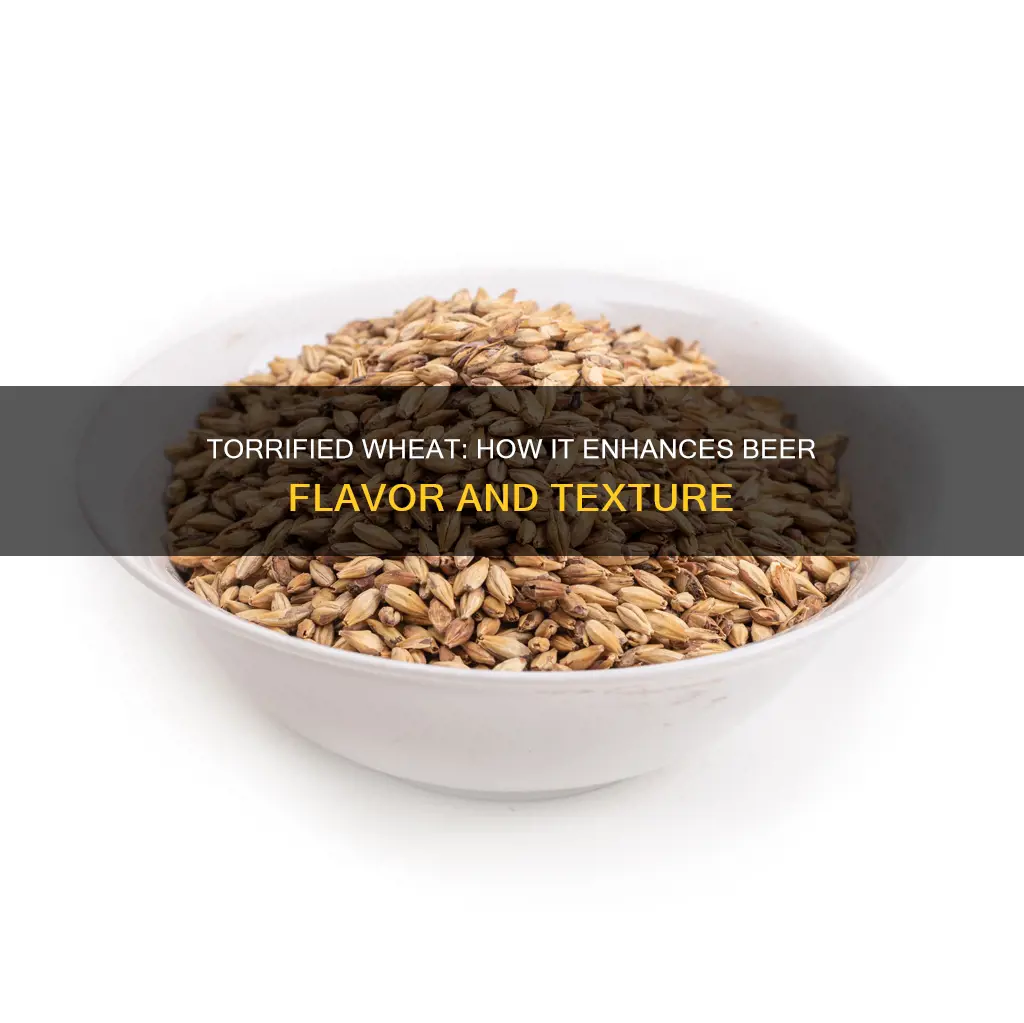
Torrified wheat is a gelatinized form of wheat used in brewing to improve head retention and mouthfeel in beer. It is created by passing raw wheat through hot air at temperatures between 400°C to 415°C, causing the cell walls of the wheat to disrupt and the grain to expand. This process makes the starches in the wheat more accessible for enzymatic breakdown and extraction. Torrified wheat has a slightly nutty or grainy flavour and can be used to replace malted wheat in the brewing process. It is high in protein, which contributes to haze in beers such as hazy IPAs.
| Characteristics | Values |
|---|---|
| Flavour | Very slightly nutty |
| SRM | 1.5 |
| Mouthfeel | Improved |
| Head Retention | Improved |
| Haze | Initial |
| Body | Increased |
| Usage Rate | Less than 20% |
| Beer Styles | English cask ales, Belgians |
What You'll Learn
- Torrified wheat is a pre-gelatinized unmalted wheat that can be used as a cereal grain/adjunct in the mash
- Torrified wheat can replace malted wheat in beer
- Torrified wheat improves head retention and increases body
- Torrified wheat has a slightly nutty or toasted flavour
- Torrified wheat is best used in moderation, at less than 20% to avoid a popcorn aroma

Torrified wheat is a pre-gelatinized unmalted wheat that can be used as a cereal grain/adjunct in the mash
Torrified wheat is a pre-gelatinized unmalted wheat that can be used as a cereal grain or adjunct in the mash. It is produced by passing raw wheat through a fluidised bed of hot air at temperatures between 400°C to 415°C for 30 to 40 seconds. This process disrupts the cell walls of the wheat, causing the grain to expand and form tiny wheat footballs. The resulting torrified wheat is pre-gelatinised, which means it can be crushed or flaked and added directly to the mash without milling.
Torrified wheat has a very slightly nutty or grainy flavour and can be used to replace malted wheat in beer recipes. It increases body and head retention and adds a very slight toasted flavour to the beer. Torrified wheat is particularly useful when base malts are low in nitrogen or protein. It is recommended to use rice hulls with this grain to avoid a stuck mash.
The torrefaction process is similar to popping popcorn, and it makes the starches in the wheat more available for enzymatic breakdown and extraction during mashing. This process also results in higher molecular weight proteins and glycoproteins, which are head-positive and promote mouthfeel. Torrified wheat has a neutral flavour profile, allowing brewers to enhance and showcase the flavours from other ingredients in their beer.
Torrified wheat is commonly used in English cask ales, but it can also work well in Belgian beers and Witbiers. It can be used interchangeably with flaked wheat, although it imparts a slight "popcorn" aroma at high levels, so it is best to use it at less than 20% in the grain bill.
Coors Beer: Wheat-Free Refreshment or Not?
You may want to see also

Torrified wheat can replace malted wheat in beer
Torrified wheat is a pre-gelatinized unmalted brewer's wheat that can be used as a cereal grain or adjunct in the mash. It can replace malted wheat if desired. Torrified wheat undergoes a process called torrefaction, a heating process like popping popcorn, which disrupts the raw endosperm structure and breaks down the internal starch binding structure of the kernel. This makes the starches more accessible for enzymatic breakdown and extraction.
Torrified wheat has a very slight nutty flavor and can increase body and head retention in beer. It is especially useful when base malts are low in nitrogen/protein. The higher molecular weight proteins and glycoproteins in torrified wheat promote mouthfeel and improve head retention.
When using torrified wheat, it is recommended to use rice hulls with this grain to avoid a stuck mash. Torrified wheat does not require milling before mashing as it is already pre-gelatinized. However, if it is whole kernel torrified wheat, it can be milled along with other grains.
In summary, torrified wheat can be used as a substitute for malted wheat in beer, providing a slightly nutty flavor, improved body, and head retention.
Yuengling Lager: Wheat Beer or Not?
You may want to see also

Torrified wheat improves head retention and increases body
Torrified wheat is a pre-gelatinized unmalted brewer's wheat that can be used as a cereal grain or adjunct in the mash. It has a variety of uses and benefits in the brewing process, including improving head retention and increasing body.
Head retention is essential in brewing beer as it affects the overall presentation and taste experience. Torrified wheat contains higher molecular weight proteins and glycoproteins that positively impact head retention. These proteins also promote mouthfeel, enhancing the overall sensory experience of the beer. This is especially beneficial when base malts are low in nitrogen or protein.
In addition to improving head retention, torrified wheat also increases the body of the beer. The wheat itself is high in protein, with protein contents ranging from 5 to 10%. This high protein content contributes to the overall body and depth of the beer, adding to the sensory experience.
The process of torrefaction involves passing raw wheat through a fluidised bed of hot air at temperatures between 400°C and 415°C. This intense and quick heating method disrupts the cell walls of the wheat, causing the grain to expand and form tiny wheat footballs. This process results in the pre-gelatinisation of the wheat, making it ready for addition to the mash after crushing or flaking.
Torrified wheat has a slightly nutty or grainy flavour, akin to puffed wheat or popcorn. This subtle flavour can enhance the overall taste profile of the beer without overwhelming it. It is a versatile ingredient that can be used in various beer styles, including English cask ales and Belgian beers.
In summary, torrified wheat is a valuable ingredient in brewing, offering improved head retention, increased body, and a subtle flavour that complements and enhances the overall sensory experience of the beer. Its high protein content and unique processing method make it a useful tool for brewers looking to add depth and character to their creations.
Floridian Beer: Wheat or Not Wheat?
You may want to see also

Torrified wheat has a slightly nutty or toasted flavour
Torrified wheat is a pre-gelatinized unmalted brewer's wheat that can be used as a cereal grain or adjunct in the mash. It can replace malted wheat and increase body and head retention. Torrified wheat has a slightly nutty or toasted flavour, akin to puffed wheat or popcorn. It is created by passing raw wheat through a fluidised bed of hot air at temperatures between 400°C to 415°C for 30 to 40 seconds. This process disrupts the cell walls of the wheat, causing the grain to expand and form tiny wheat footballs. Torrified wheat is then pre-gelatinised and can be crushed or flaked before adding to the mash.
The torrefaction process is similar to popping popcorn, and it imparts a unique flavour and texture to the wheat. The heating process breaks down the internal starch structure of the kernel, making it more available for enzymatic breakdown and extraction during brewing. This process results in a slightly nutty or toasted flavour that can enhance the taste of beer.
The nutty flavour of torrified wheat can add depth and complexity to the beer's flavour profile. It can be used in various beer styles, such as English cask ales and Belgians. When used in moderate amounts, it can contribute to a clean, grainy flavour without overpowering the other ingredients.
Additionally, torrified wheat is high in protein, which aids in head formation and retention and adds body to the beer. The protein content also contributes to haze formation, making it a suitable ingredient for hazy IPAs. However, it is important to note that the larger molecular proteins in torrified wheat may not float for an extended period, so a mix of wheat types and other cereals might be preferable for a permanent haze.
Overall, torrified wheat is a versatile ingredient that can improve the flavour, body, and head retention of beer while adding a subtle nutty or toasted note to the final product.
Sour Beers: Do They Contain Wheat?
You may want to see also

Torrified wheat is best used in moderation, at less than 20% to avoid a popcorn aroma
Torrified wheat is a pre-gelatinized unmalted brewer's wheat that can be used as a cereal grain or adjunct in the mash. It increases body and
Torrified wheat is typically used in small percentages, especially in traditional English ales and bitters. It is added to the end of the grain bill to improve head retention. Wheat has a much larger percentage of protein than barley, and this protein helps to stabilize beer foam and add body to the beer. A good starting point for the amount of torrified wheat to use is 5-10% of the grist, which can be increased to around 20% for wheat beers like witbiers and German wheat beers. However, using more than 20% of torrified wheat in a beer recipe may result in a popcorn aroma, which may not be desirable.
It is important to note that torrified wheat does not have any diastatic power of its own, meaning it relies on the diastatic power of pale or lager malts to convert the starches in a mash. This is why the maximum recommended amount of torrified wheat in a grain bill is around 40%. Additionally, when using torrified wheat, it is recommended to use rice hulls to avoid a stuck mash.
Blue Moon Beer: Wheat or Not?
You may want to see also
Frequently asked questions
Torrified wheat is a pre-gelatinized unmalted brewer's wheat that can be used as a cereal grain/adjunct in the mash. It is created by passing raw wheat through a fluidised bed of hot air at temperatures between 400°C to 415°C.
Torrified wheat improves head retention and increases body, adding a very slight toasted, nutty flavor.
Torrified wheat has a more neutral flavor profile compared to wheat malt, which has a deliciously creamy, light, and doughy taste. Torrified wheat is also high in protein, which aids in head formation and contributes to haze.
Torrified wheat is commonly used in English cask ales but can also work well in Belgian beers and IPAs. It is a good choice when you want to improve head formation and add body to your beer without imparting distinct wheat malt flavors.
Torrified wheat comes in two forms: whole kernel and flaked. If using the whole kernel, it is recommended to mill it along with your other grains. However, if using the flaked form, milling is not necessary as it can be mashed as is.







